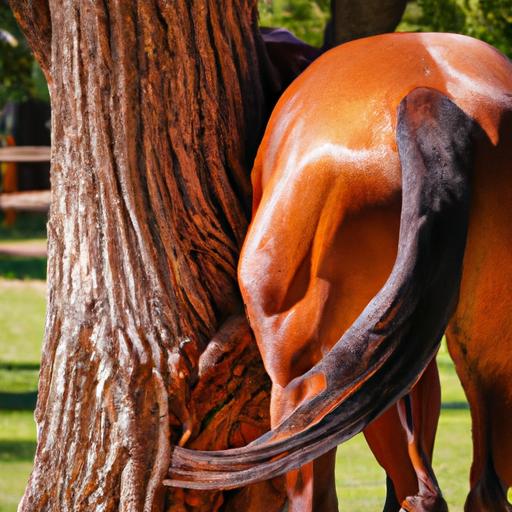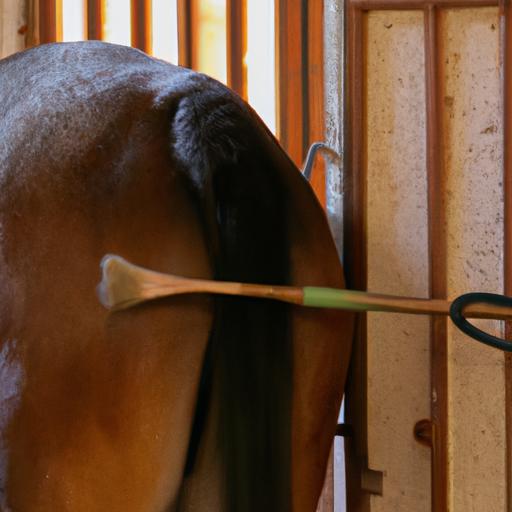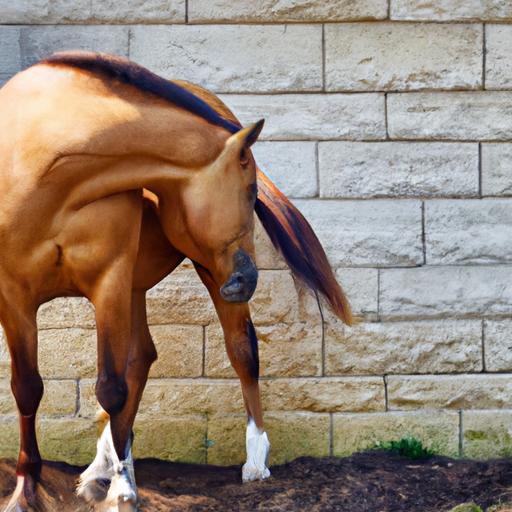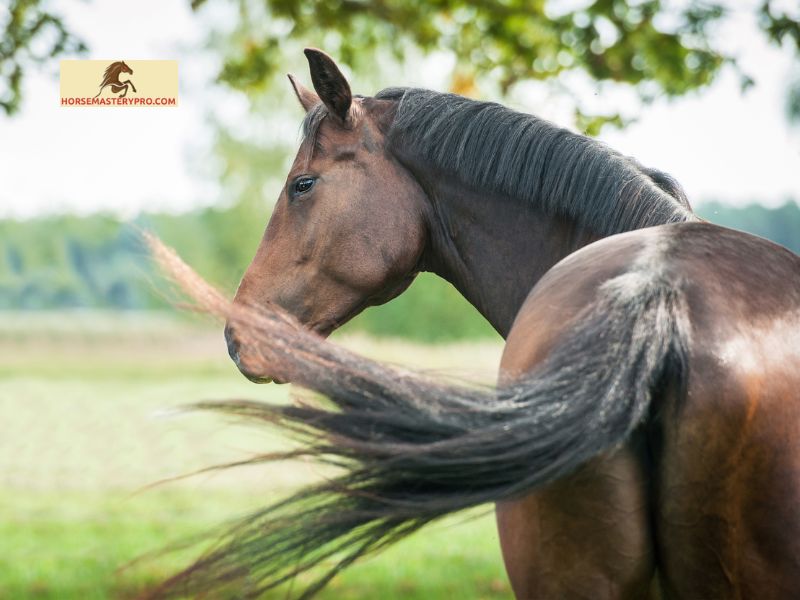Discover the potential causes of tail rubbing in horses, from parasites to allergies and behavioral factors. Learn how to address this behavior for your equine companion’s well-being.
Introduction

Have you ever noticed your beloved horse rubbing its tail against fences, posts, or even its own body? It’s a perplexing sight, isn’t it? Well, you’re not alone in wondering what drives this behavior. In this article, I’ll delve into the world of tail rubbing in horses, exploring its potential causes and emphasizing the importance of understanding and addressing this behavior.
Tail rubbing, also known as “tail itching” or “tail scratching,” refers to the act of a horse rubbing its tail against various surfaces. It can manifest in different forms, ranging from gentle swishing to vigorous rubbing and even tail rubbing so intense that it leads to hair loss and skin damage. While it may seem like a harmless habit, tail rubbing can indicate underlying issues that require attention.
Understanding why horses engage in tail rubbing is crucial for their overall well-being. It’s not merely a matter of aesthetics; it’s about ensuring your equine companion’s health and happiness. By identifying and addressing the root causes, we can effectively alleviate this behavior and prevent potential complications.
In the following sections, we’ll explore the potential causes of tail rubbing in horses, delve into the various underlying issues that may contribute to this behavior, and discuss appropriate management techniques and preventive measures. By the end of this article, you’ll be equipped with the knowledge needed to decipher the reasons behind your horse’s tail rubbing and take appropriate action.
So, let’s dive deeper into the intriguing world of tail rubbing in horses and discover how we can help our equine friends find relief from this persistent itch. Together, we can enhance the bond between you and your horse while ensuring their optimal comfort and well-being. Stay tuned for more insights into this fascinating phenomenon!
Stay tuned for the upcoming sections where we will explore the potential causes, identification, and treatment of tail rubbing in horses.
Understanding Tail Rubbing in Horses

Definition of Tail Rubbing and Its Common Manifestations
To comprehend the intricacies of tail rubbing in horses, let’s start by defining this behavior. Tail rubbing refers to the act of a horse rubbing its tail against various surfaces, including fences, posts, trees, or even its own body. It can manifest in several ways, ranging from gentle swishing to more vigorous rubbing and scratching motions.
Discussion on Why Horses Engage in This Behavior
Now, you might wonder, why do horses engage in tail rubbing? Well, the reasons behind this behavior can be multifaceted. Let’s explore a few potential explanations:
1. Parasites and Irritation
One common cause of tail rubbing in horses is the presence of parasites, such as pinworms or lice. These pesky critters can irritate the horse’s tail area, leading to discomfort and a strong urge to rub. It’s crucial to be vigilant about deworming protocols and regularly check for signs of parasitic infestation.
2. Allergies and Skin Conditions
Horses, like humans, can develop allergies and skin conditions that cause itching and irritation. Allergens from hay, bedding, or insect bites can trigger an allergic reaction, leading to tail rubbing. Additionally, skin conditions like dermatitis or fungal infections can contribute to this behavior. Identifying and addressing these underlying allergies and skin issues is essential for effective management.
3. Behavioral Factors
Tail rubbing can also be a result of behavioral factors. Horses may engage in this behavior out of boredom, frustration, or anxiety. Inadequate mental and physical stimulation, lack of social interaction, or stressful environments can all contribute to tail rubbing. Providing enriching activities, companionship, and a calm, harmonious environment can help alleviate this type of tail rubbing.
By understanding the potential causes of tail rubbing in horses, we lay the foundation for effective management and prevention strategies. In the upcoming sections, we’ll delve deeper into these causes, exploring how parasites, allergies, skin conditions, and behavioral factors impact tail rubbing. So, let’s continue our journey to unravel the mysteries behind this intriguing behavior.
Stay tuned for the next sections where we will explore the potential causes of tail rubbing, including parasites, allergies, skin conditions, and behavioral factors.
Identifying and Treating Underlying Issues

When it comes to addressing tail rubbing in horses, a crucial step is identifying and treating the underlying issues causing this behavior. It’s essential to seek the expertise of a veterinarian or equine specialist to ensure an accurate diagnosis and appropriate treatment plan. Let’s explore the key aspects of this process:
Importance of proper diagnosis by a veterinarian or equine specialist
Before embarking on any treatment journey, it’s imperative to obtain a proper diagnosis from a qualified professional. A veterinarian or equine specialist will conduct a thorough examination of your horse, taking into account their medical history, current symptoms, and any relevant factors. This comprehensive evaluation will help pinpoint the specific cause of tail rubbing and guide subsequent treatment decisions.
Diagnostic tests and assessments to determine the cause of tail rubbing
In order to identify the root cause of tail rubbing, various diagnostic tests and assessments may be necessary. These may include skin scrapings, blood tests, and allergy testing to rule out potential parasites, allergies, or underlying skin conditions. Additionally, a behavioral analysis may be conducted to assess whether boredom, anxiety, or other psychological factors contribute to the behavior.
Tailored treatment plans for specific underlying issues
Once the cause of tail rubbing has been determined, a tailored treatment plan can be developed to address the underlying issue effectively. This plan may include a combination of medications, topical treatments, dietary adjustments, and environmental modifications. For instance, if parasites are the culprit, deworming protocols may be recommended. If allergies or skin conditions are at play, specific medications or dietary changes may be prescribed.
Remember, each horse is unique, and their treatment plan should be tailored to their individual needs. Regular follow-ups with your veterinarian or equine specialist are essential to monitor progress, make adjustments if needed, and ensure your horse’s well-being.
Stay tuned for the upcoming sections where we will discuss preventive measures and management techniques to reduce tail rubbing in horses.
Preventive Measures and Management Techniques
Regular Grooming and Hygiene Practices
One of the key preventive measures in addressing tail rubbing is maintaining a regular grooming routine for your horse. Regularly brush and clean their tail, ensuring it is free from dirt, debris, and any potential irritants. Use a gentle, horse-friendly shampoo and conditioner to keep the tail clean and moisturized, reducing the risk of itching and irritation. Additionally, consider using a tail detangler or conditioner to prevent tangles and knots, which can contribute to tail rubbing.
Environmental Modifications
Making certain modifications to the horse’s environment can significantly reduce factors that trigger tail rubbing. Ensure that their living space is clean and free from potential irritants, such as excessive dust, pollen, or mold. Implement measures to minimize the presence of flies and other pests, such as using fly repellents, installing fly traps or screens, and providing shelter that offers protection from insects. Additionally, consider using tail guards or wraps to prevent the tail from coming into contact with surfaces that may cause irritation.
Strategies for Mental and Physical Stimulation
Boredom and anxiety can also lead to tail rubbing in horses. To address this, provide your equine companion with ample mental and physical stimulation. Engage in regular exercise and turnout to allow them to move and stretch freely, which can help alleviate boredom-related tail rubbing. Incorporate a variety of activities into their routine, such as trail rides, obstacle courses, or even simple ground exercises, to keep their minds engaged and prevent repetitive behaviors.
Consider using toys or treat-dispensing devices designed specifically for horses to provide additional mental stimulation. Offering them a stable herd dynamic and social interaction with other horses can also contribute to their overall well-being and reduce anxiety-related behaviors.
By implementing these preventive measures and management techniques, you can significantly reduce the likelihood of tail rubbing in your horse. Remember, tail rubbing is often a symptom of an underlying issue, so it’s crucial to address both the behavior and the root cause. Stay proactive in your horse’s care and provide them with a comfortable, stimulating environment to ensure their tail remains itch-free.
In the upcoming section, we will conclude our discussion on tail rubbing in horses, summarizing key points and emphasizing the importance of seeking professional advice. Stay tuned!
Conclusion
In conclusion, understanding tail rubbing in horses is essential for responsible horse owners and caretakers. By recognizing this behavior and delving into its potential causes, we can address the underlying issues and provide our equine companions with the care they deserve.
Throughout this article, we have explored the various aspects of tail rubbing in horses. We’ve learned that parasites, allergies, skin conditions, and even behavioral factors can contribute to this behavior. It is crucial to consult with a veterinarian or equine specialist to accurately diagnose the cause of tail rubbing in your horse.
To effectively address tail rubbing, tailored treatment plans should be implemented based on the underlying cause. This may include deworming protocols to combat parasites, managing allergies or skin conditions through medication or dietary adjustments, and addressing behavioral issues through environmental modifications and mental and physical stimulation.
Remember, prevention is key. Regular grooming and hygiene practices, such as cleaning the tail and inspecting for any signs of irritation or infestation, can help reduce the likelihood of tail rubbing. Creating an enriching and stimulating environment for your horse can also minimize boredom-related tail rubbing.
As horse enthusiasts, it is our responsibility to prioritize the health and well-being of our equine companions. Understanding and addressing tail rubbing not only enhances their comfort but also strengthens the bond we share with them.
If you find your horse exhibiting tail rubbing behavior, don’t hesitate to seek professional advice. By taking the necessary steps to identify and treat the underlying issues, you can ensure your horse’s happiness and overall quality of life.
Thank you for joining me on this journey to unravel the mysteries of tail rubbing in horses. For more valuable insights and content related to horse care, visit horsemasterypro.com. Together, let’s continue to nurture our equine friends and deepen our understanding of their unique needs.
Stay tuned for more informative articles on horsemasterypro.com!


